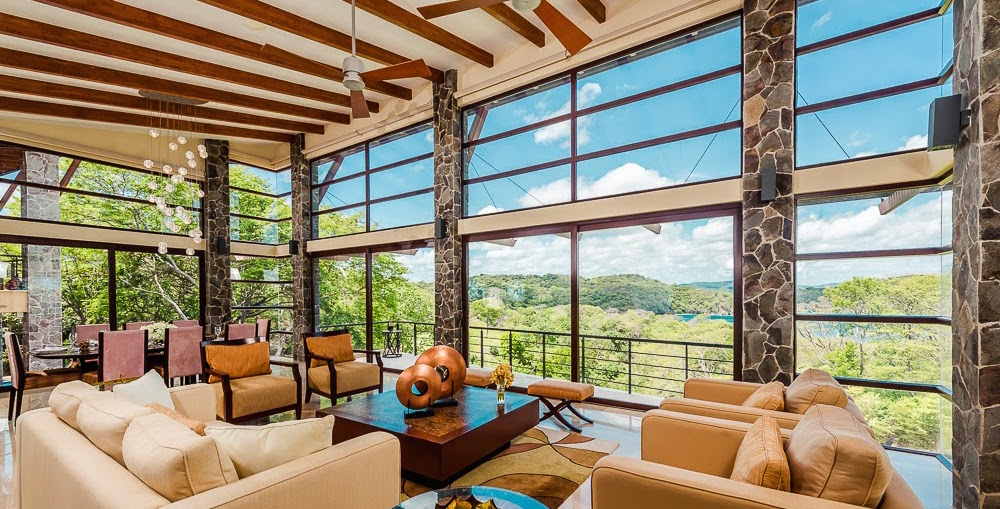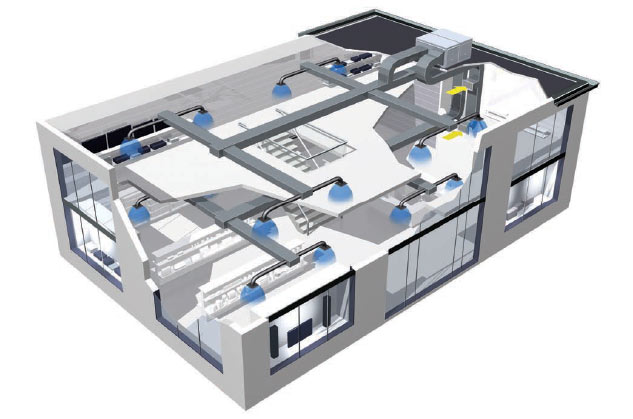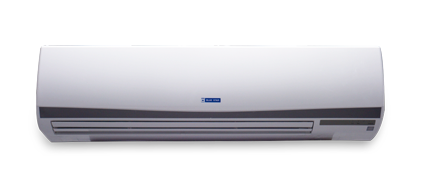Today I thought I would share some ideas about my recommendations on air conditioning systems for your vacation home in Costa Rica. At SARCO Architects Costa Rica, we have been designing vacation homes for the past 10 years, and therefore we have a pretty good deal of experience in the use of the different types of air conditioning systems, from the basic to the more sophisticated.

Good architectural design of technical elements like air conditioning make the difference in making your home a special place.
I will attempt not going into too much of complex technical details and keep this easy to understand and to provide valuable practical tips for you to consider for your project. At the same time, this will not be a extensive white paper into all types of A/C systems, but intended to be recommendations on the use of different type of systems for residential use.
I will separate the systems based on their types of condenser (heat exchanger) technology, since that is what determines the main differences between them. We will talk about direct expansion systems, chilled-water systems, and variable ratio flow systems (VRF).
Basic explanation of system parts
All air conditioning systems have two parts for their operation. These are called the evaporators (sometimes referred to as air-handlers) and the condensers. The evaporators are the units that are placed inside your rooms, and are the ones that provide cold air. The condensers are the units that are placed outside the home, and that handle the heat exchange from the interior to the exterior, and provide the coolant to the evaporators so they can provide cold air to the interior.
Ducted or Non-Ducted Air Conditioning Systems?
Let’s first begin by giving a quick explanation of the differences between how a system distributes the cooled air into your home. This is the first choice that you need to make when giving your architect the initial pointers and parameters for designing your system.
Ducted Systems
Ducted split systems are those where a system can be designed to supply cooled air to several spaces from a single evaporator. Ducted systems can be designed to supply cool air to whatever spaces you desire. These systems are more expensive since additional to the cost of the equipment, you need to build ducting and provide grilles for supply and return of air to the evaporator. In ducted systems the evaporators are typically placed inside an equipment closet or in the ceiling space.
Ducted systems can be designed to provide cooling to an entire home, by breaking up the system into “zones”. A zone is what is cooled by a single evaporator, and depending on the capacity of the unit can cool a single, large room, or a combination of several smaller rooms, and the temperature is controlled by a thermostat.
Breaking up a system into more zones will not necessarily make the system more expensive, but can provide considerable energy savings, as it allows the flexibility to keep areas of the house turned off when they are not in use. If you have less zones, supplied by larger systems, inevitably you may end up cooling rooms that are not in use.
Non-Ducted Systems
Non ducted systems are those where the evaporator the provides the cooled air are placed directly inside the room. These are typical of wall-mounted or window-type units.
I won’t go into details about window-type systems. These are noisy, inefficient, and downright ugly. If you are considering a new home, there is simply no reason why to even consider a window-type unit for your new home.
Wall-mounted splits are the cheapest and most common systems. They have the disadvantage that the evaporator is placed directly inside the room, therefore it can only provide cooling to the one room where it is installed and no real air distribution is possible for other spaces.
For example, let’s say that you install a wall-mounted unit in your master bedroom. You may have cool air inside the room, but the walk-in closet and bathroom will be warm, as there will be no airflow inside those spaces. Inevitably, there is a tradeoff between lower cost and reduced comfort.
Differences in Cooling Technologies
Now let’s talk about the differences between the part of the systems that actually provide the cooling that gives you comfort in your home.
Direct Expansion Systems
Any type of air conditioning system that is a one-to-one system setup between evaporators and condensers. Any direct expansion system is that where you have one condenser to install outside the home for every evaporator to install inside the home. Direct expansion systems are window-type units, wall-mounted split units, and ducted split systems.
An important consideration when choosing ducted direct expansion systems is that typically these systems may max out at 5Tons (60,000 BTU/h) of cooling capacity per unit. Therefore, for larger rooms or open spaces you may require several units to provide the needed cooling for the space.
Also, remember that since direct expansion systems have a one-to-one relation of condenser and evaporator this means that for every zone in the home, you will have one condenser outside the home that you need to figure out where to place. This means that noise and visual considerations come into play, and this is where the architect is that one that needs to fully understand how to design an air conditioning system to properly consider all conditions from the initial preliminary design.
Also, there are limits to the maximum distance between devices of the system. Although these may vary from one manufacturer to another, a good rule of thumb is to not go above 35 to 40 meters of total piping distance between units. Condensers require clear space around them and between units of at least 3 feet, which also comes into play when designing the space needed.
Of particular importance when selecting a direct-expansion system is the choice of SEER rating. Higher SEER ratings indicate a more energy-efficient system, and can provide significant savings in the energy costs needed to run the system. As of today, the lower-end SEER ratings available in our market are SEER-13 and SEER-15. Units rated SEER-17 and SEER-21 can provide energy savings in the range of 20-30% depending on the brands, models, etc. Of course the higher the SEER rating, the higher the purchase cost of the equipment will be.
One advantage of direct-expansion systems is that if desired, the owner can invest in the new generation of “smart” wi-fi enabled thermostats, such as those from Nest, Ecobee, Honeywell or Carrier. These are remotely accessible via the web, so the user can review and control the system when they are away from home.
Water-chilled systems
Water-chilled systems are typically ducted systems, but there are some wall-mounted units also available. You may associate chiller-based systems with larger, typically commercial applications such as office or commercial spaces, but the smaller units can be considered for large residences.
The difference between chiller systems and other types of air conditioning systems is that instead of a refrigerant gas being the medium where the condenser provides cooling to the evaporators, in chiller systems this is actually cold water. This means that you will have large-diameter water pipes running a circuit to and from each evaporator to back to the condenser, all connected into a single closed loop circuit. Finding space for these large pipes in the in-ceiling spaces becomes quite a challenge.
With a chiller system, you will only have one large device (the chiller) operate as the condenser, and all evaporators are fed from this single device outside. This setup simplifies the issues of finding the space for the condensers and makes it easier to control visual and noise considerations.
Even though chiller-based systems are extremely energy efficient, to obtain the advantage of energy savings you need to be running the entire home in full-on mode. This is because the chiller either operates on or off, there is no load-balancing possible.
As an example, let’s say that you have a large residence with over 10 different zones of air conditioning. If you only have two or three zones on in the house, the chiller will still operate at full capacity in order to supply cooling for all 10 zones. In this situation the efficiency of the system is wasted. If your usage pattern of the home is such that not all the time will the entire home be used at once, probably a chiller system is not be best choice for you.
Variable Ratio Flow (VRF) Systems
The Variable Ratio Flow system is similar to a chiller in that a single condenser setup is needed to supply an entire home. VRF condensers are typically modular, therefore the more capacity needed as per the total cooling load for the house, you simply design for a “bank” of two, three, or four modules all placed side-by-side.
The main advantage of a VRF system is that it easily becomes the most energy-efficient system possible, since the condensers will vary their operating speed to provide more cooling load as zones in the home are turned on. If the system is larger and therefore modular, the more cooling capacity is required, then the second or third modules will kick in as needed. The cooling provided is only the capacity needed to cool the rooms that are desired, and not more.
A user-experience drawback of a VRF system is that since the thermostats need to do much more than send on-or-off signals to the air handlers, as they need to tell the unit to speed up or slow down, then the thermostats are proprietary to the VRF system. This means that the “smart” thermostats mentioned above (Nest, Ecobee, etc.) are not compatible with VRF systems.
One potential solution for this is viable for large luxury homes, where the owner may want to install some form of “smart-home” system such as those available from brands such as Crestron, Control4, Élan, etc. These systems can be connected via converters and a control language called BacNet, so that these devices can provide control for the air conditioning system.
Insulation and energy efficiency
You may be familiar with the importance of insulation for reasons of keeping heat inside your home in colder climates. In our tropical location, good insulation qualities are needed for the exact opposite reasons, to keep the heat out. Heat passage into the home means that your air conditioning system needs to fight against the heat passage to cool the inside of your home.
Being able to control heat from making it inside your home provides two advantages: it reduces the total cooling capacity of the system, giving you a less expensive system (initial investment) and it also reduces the energy demand, lowering your monthly energy bill.
In the next few weeks I will provide an article speaking about the best strategies for insulation and to keep the heat outside your home in our tropical location in Costa Rica.
Architectural Expertise in HVAC design and integrated project philosophy.
One of the faults of many architectural service providers is the lack of knowledge about how to conceptualize and properly design an air conditioning system. The task gets handed off to the HVAC engineer, who will concentrate on issues such as proper load calculation, proper duct sizing, airflow calculation, etc., but not necessarily in the visual or aesthetic considerations. This is where the architect needs to be the one to be the leader for the design task and to coordinate all elements of the design, considering both the technical and aesthetic.
 We will be glad to assist you in the design of your vacation home in Costa Rica, and will bring our knowledge and expertise to make your home a really special place to relax and enjoy the tropical paradise. A properly designed air conditioning system is a big part of allowing your enjoyment of your vacation home in Costa Rica, which allows you to escape to the comfort of the inside of your home when the afternoon heat is making things a bit too hot to handle. We at SARCO Architects Costa Rica have designed homes with all kinds of air conditioning systems and know when to design and specify one system over another for different project types and client requirements.
We will be glad to assist you in the design of your vacation home in Costa Rica, and will bring our knowledge and expertise to make your home a really special place to relax and enjoy the tropical paradise. A properly designed air conditioning system is a big part of allowing your enjoyment of your vacation home in Costa Rica, which allows you to escape to the comfort of the inside of your home when the afternoon heat is making things a bit too hot to handle. We at SARCO Architects Costa Rica have designed homes with all kinds of air conditioning systems and know when to design and specify one system over another for different project types and client requirements.






Thanks for the great share! I also like the idea of Home Efficiency. The best part I like is this: The reliability and availability of modern energy sources cause people to tend to assume that it will always be accessible. And as for the case of non-renewable energy sources, most people do not know or maybe even refuse to accept that it will eventually run out.
Terrific Article – this helped me make the decision I needed, thanks for the detail.